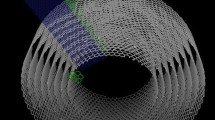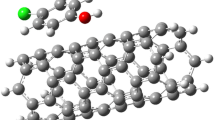Abstract
In this work, three quantitative structure–activity relationship (QSAR) methods involving comparative molecular field analysis (CoMFA) and GRid-INdependent Descriptors (GRIND) based 3D-QSAR and hologram QSAR (HQSAR) were evaluated for predicting adsorption coefficients of the simple benzene derivatives on mutiwalled carbon nanotubes (MWCNTs). The contour maps of CoMFA suggested that the steric hindrance had a significant impact on the adsorption process of substituted benzenes. GRIND studies investigate the important mutual distances between molecular features, which confirmed the role of hydrophobic groups as well as their distances from different steric hot spots in the benzene ring of the molecules. According to HQSAR model and its fragment contribution map, the hydrogen bond donor and acceptor were also found to play an important role in governing adsorption of substituted benzenes on CNTs. The CoMFA, GRIND, and HQSAR methods employed to build predictive 2D- and 3D-QSAR models for adsorption of simple benzene derivatives on CNTs in aqueous media successfully.






Similar content being viewed by others
Availability of data and material
Not applicable.
Code availability
Not applicable.
References
Ren X, Chen C, Nagatsu M, Wang X (2011) Carbon nanotubes as adsorbents in environmental pollution management: a review. Chem Eng J 170(2–3):395–410
Sinha N, Ma J, Yeow JT (2006) Carbon nanotube-based sensors. J Nanosci Nanotechnol 6(3):573–590
Apul OG, Karanfil T (2015) Adsorption of synthetic organic contaminants by carbon nanotubes: a critical review. Water Res 68:34–55
Hyung H, Kim JH (2008) Natural organic matter (NOM) adsorption to multi-walled carbon nanotubes: effect of NOM characteristics and water quality parameters. Environ Sci Technol 42(12):4416–4421
Gupta VK, Moradi O, Tyagi I, Agarwal S, Sadegh H, Shahryari-Ghoshekandi R, Garshasbi A (2016) Study on the removal of heavy metal ions from industry waste by carbon nanotubes: effect of the surface modification: a review. Crit Rev Environ Sci Technol 46(2):93–118
Stafiej A, Pyrzynska K (2007) Adsorption of heavy metal ions with carbon nanotubes. Sep Purif Technol 58(1):49–52
Liu X, Zhang S, Pan B (2012) Potential of carbon nanotubes in water treatment. Recent Progress in Carbon Nanotube Research/Book 2, Provisional chapter
Ong YT, Ahmad AL, Zein SHS, Tan SH (2010) A review on carbon nanotubes in an environmental protection and green engineering perspective. Braz J Chem Eng 27(2):227–242
Huff J (2007) Benzene-induced cancers: abridged history and occupational health impact. Int J Occup Environ Health 13(2):213–221
Salahinejad M, Ghasemi JB (2014) 3D-QSAR studies on the toxicity of substituted benzenes to Tetrahymena pyriformis: CoMFA, CoMSIA and VolSurf approaches. Ecotoxicol Environ Saf 105:128–134
Tranfo G (2011) Benzene and its derivatives: new uses and impacts on environment and human health. Nova Science Pub Incorporated
Rashed MN (2013) Adsorption technique for the removal of organic pollutants from water and wastewater. Organic Pollutants: Monitoring, Risk and Treatment, Intech Publisher Croatia
Amin MT, Alazba AA, Manzoor U (2014) A review of removal of pollutants from water/wastewater using different types of nanomaterials. Adv Mater Sci Eng 2014
Woods LM, Bădescu ŞC, Reinecke TL (2007) Adsorption of simple benzene derivatives on carbon nanotubes. Phys Rev B 75(15):155415
Collins PG (2010) Defects and disorder in carbon nanotubes. Oxford University Press, Oxford
Brooks AJ, Lim HN, Kilduff JE (2012) Adsorption uptake of synthetic organic chemicals by carbon nanotubes and activated carbons. Nanotechnology 23(29):294008
Rieth M, Schommers W (2007) Handbook of theoretical and computational nanotechnology. Volume 7: magnetic nanostructures and nano-optics. American Scientific Publishers
Cruciani G, Carosati E, Clementi S (2003) Three-dimensional quantitative structure-property relationships. The practice of medicinal chemistry
Dearden JC (2017) The history and development of quantitative structure-activity relationships (QSARs). In: Oncology: breakthroughs in research and practice. IGI Global, pp 67–117
Ghasemi JB, Salahinejad M, Rofouei MK (2011) Review of the quantitative structure–activity relationship modelling methods on estimation of formation constants of macrocyclic compounds with different guest molecules. Supramol Chem 23(9):614–629
Langer T, Bryant SD (2008) 3D quantitative structure–property relationships. In: The practice of medicinal chemistry. Academic Press, pp 587–604
Roy K, Kar S, Das RN (2015) Understanding the basics of QSAR for applications in pharmaceutical sciences and risk assessment. Academic press
Salahinejad M (2015) Application of classification models to identify solvents for single-walled carbon nanotubes dispersion. RSC Adv 5(29):22391–22398
Burello E, Worth AP (2011) QSAR modeling of nanomaterials. Wiley Interdiscip Rev Nanomed Nanobiotechnol 3(3):298–306
Salahinejad M, Zolfonoun E (2013) QSAR studies of the dispersion of SWNTs in different organic solvents. J Nanopart Res 15(11):1–9
Toropova AP, Toropov AA, Veselinović AM, Veselinović JB, Benfenati E, Leszczynska D, Leszczynski J (2016) Nano-QSAR: model of mutagenicity of fullerene as a mathematical function of different conditions. Ecotoxicol Environ Saf 124:32–36
Winkler DA (2016) Recent advances, and unresolved issues, in the application of computational modelling to the prediction of the biological effects of nanomaterials. Toxicol Appl Pharmacol 299:96–100
Damale G, Harke MN, Kalam SA, Khan FB, Shinde DN, Sangshetti J (2014) Recent advances in multidimensional QSAR (4D–6D): a critical review. Mini Rev Med Chem 14(1):35–55
Verma J, Khedkar VM, Coutinho EC (2010) 3D-QSAR in drug design-a review. Curr Top Med Chem 10(1):95–115
Xia XR, Monteiro-Riviere NA, Riviere JE (2010) An index for characterization of nanomaterials in biological systems. Nat Nanotechnol 5(9):671–675
Cramer RD, Patterson DE, Bunce JD (1988) Comparative molecular field analysis (CoMFA). 1. Effect of shape on binding of steroids to carrier proteins. J Am Chem Soc 110(18):5959–5967
Kubinyi H (2002) Comparative molecular field analysis (CoMFA). Encyclopedia of Computational Chemistry. John Wiley & Sons, Ltd
Pastor M, Cruciani G, Clementi S (1997) Smart region definition: a new way to improve the predictive ability and interpretability of three-dimensional quantitative structure−activity relationships. J Med Chem 40(10):1455–1464
Duran A, Martínez GC, Pastor M (2008) Development and validation of AMANDA, a new algorithm for selecting highly relevant regions in molecular interaction fields. J Chem Inf Model 48(9):1813–1823
Baroni M, Costantino G, Cruciani G, Riganelli D, Valigi R, Clementi S (1993) Generating optimal linear PLS estimations (GOLPE): an advanced chemometric tool for handling 3D-QSAR problems. Quant Struct-Act Relat 12(1):9–20
Tong W, Lowis DR, Perkins R, Chen Y, Welsh WJ, Goddette DW, Sheehan DM (1998) Evaluation of quantitative structure−activity relationship methods for large-scale prediction of chemicals binding to the estrogen receptor. J Chem Inf Comput Sci 38(4):669–677
Doddareddy MR, Lee YJ, Cho YS, Choi KI, Koh HY, Pae AN (2004) Hologram quantitative structure activity relationship studies on 5-HT6 antagonists. Bioorg Med Chem 12(14):3815–3824
Ugarkar AG, Ambre PK, Coutinho EC, Nandan S, Pissurlenkar RR (2014) Extracting structural requirements for activity of GPR119 agonists: a hologram quantitative structure activity relationship (HQSAR) study. Can J Chem 92(7):670–676
Wold S et al (2001) PLS-regression: a basic tool of chemometrics. Chem Intell Lab Sys 58:109–130
Cramer RD III, Bunce JD, Patterson DE, Frank IE (1988) Crossvalidation, bootstrapping, and partial least squares compared with multiple regression in conventional QSAR studies. Quant Struct-Act Relat 7(1):18–25
Tropsha A, Gramatica P, Gombar VK (2003) The importance of being earnest: validation is the absolute essential for successful application and interpretation of QSPR models. QSAR Comb Sci 22(1):69–77
Roy K, Das RN, Ambure P, Aher RB (2016) Be aware of error measures. Further studies on validation of predictive QSAR models. Chemom Intell Lab Syst 152:18–33
Pan B, Xing B (2008) Adsorption mechanisms of organic chemicals on carbon nanotubes. Environ Sci Technol 42(24):9005–9013
Fontaine F, Pastor M, Sanz F (2004) Incorporating molecular shape into the alignment-free Grid-Independent Descriptors. J Med Chem 47(11):2805–2815
Xia XR, Monteiro-Riviere NA, Mathur S, Song X, Xiao L, Oldenberg SJ, Riviere JE (2011) Mapping the surface adsorption forces of nanomaterials in biological systems. ACS Nano 5(11):9074–9081
Liu Y, Zhang J, Chen X, Zheng J, Wang G, Liang G (2014) Insights into the adsorption of simple benzene derivatives on carbon nanotubes. RSC Adv 4(101):58036–58046
Roy K, Chakraborty P, Mitra I, Ojha PK, Kar S, Das RN (2013) Some case studies on application of “rm2” metrics for judging quality of quantitative structure–activity relationship predictions: emphasis on scaling of response data. J Comput Chem 34(12):1071–1082
Gramatica P (2007) Principles of QSAR models validation: internal and external. QSAR Comb Sci 26(5):694–701
Jaworska J, Nikolova-Jeliazkova N, Aldenberg T (2005) QSAR applicability domain estimation by projection of the training set in descriptor space: a review. Altern Lab Anim 33(5):445–459
Funding
The authors are thankful to the Lorestan University high education Research Council for the financial support of this research.
Author information
Authors and Affiliations
Contributions
NS: conceptualization, methodology, writing—review and editing, project administration, supervision, and funding acquisition. FM: validation, formal analysis, investigation, resources, data curation, writing—original draft.
Corresponding author
Ethics declarations
Conflict of interest
The authors declare no competing interests.
Additional information
Publisher's Note
Springer Nature remains neutral with regard to jurisdictional claims in published maps and institutional affiliations.
Rights and permissions
About this article
Cite this article
Mansouri, F., Sarlak, N. Exploring structural requirements of simple benzene derivatives for adsorption on carbon nanotubes: CoMFA, GRIND, and HQSAR. Struct Chem 34, 413–424 (2023). https://doi.org/10.1007/s11224-022-01973-5
Received:
Accepted:
Published:
Issue Date:
DOI: https://doi.org/10.1007/s11224-022-01973-5




